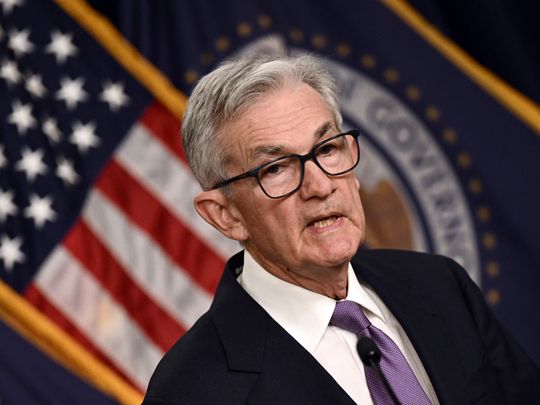
Investors are sharply raising their expectations for a significant 50 basis point interest rate cut by the Federal Reserve at its upcoming meeting on 18 September, representing the first rate reduction in over four years. This shift follows concerns that persistently high rates, currently at a 23-year high of 5.25—5.5%, could severely hamper economic growth.
Traders in swaps markets now see nearly a 50% probability of a half-percentage-point cut, up from just 15% earlier, as recent inflation and employment data present a mixed picture of the US economy. Headline inflation has decreased to 2.5%, nearing the Fed’s 2% target, but core inflation, especially driven by housing costs, remains sticky, complicating the central bank’s decision.
A larger-than-usual rate cut could serve as a pre-emptive move to cushion the economy against further slowing, particularly as labour market weakness emerges. While the Fed traditionally moves in smaller, quarter-point increments, a 50 basis point cut could signal a more aggressive stance in response to these emerging vulnerabilities.
US economic activity has slowed from mid-July to late August, as detailed in the Federal Reserve’s Beige Book, with nine of the twelve districts reporting flat or declining growth, up from five districts in the prior period. Businesses have become increasingly selective in hiring due to demand uncertainties and higher borrowing costs, pushing job openings to a 3.5-year low in July and the unemployment rate to 4.3%, the highest in nearly three years.
While layoffs remain limited, firms have been reducing shifts, hours, and workforce sizes through attrition, signalling a softening labour market.
Slowdown in employment growth
Despite these headwinds, the Fed remains focused on engineering a “soft landing,” aiming to slow economic growth without triggering a recession, while bringing inflation down to its 2% target.
The slowdown in employment growth, coupled with a dip in consumer spending — particularly in sectors like retail and automotive, due to high financing costs — reflects the balancing act the Fed faces.
Since the pandemic’s onset in early 2020, global central banks have responded with a variety of monetary policy adjustments to manage the economic fallout and inflationary pressures. Initially, most economies implemented rate cuts to mitigate the severe economic contraction caused by lockdowns and supply chain disruptions.
For instance, countries such as Brazil, India, and China swiftly reduced policy rates, while others like Japan and the Eurozone maintained an accommodative stance.
However, as inflation surged globally by mid-2021, driven by supply-side constraints, energy price shocks, and post-pandemic demand recovery, central banks in several regions, particularly in the US, UK, and Latin America, initiated aggressive rate hikes.
This trend continued throughout 2022 and into 2023, with countries like Hungary, Chile, and Mexico implementing some of the steepest increases to combat inflationary pressures, while economies like Japan and Switzerland maintained low rates due to muted inflationary concerns.
As inflationary momentum has started to slow in 2023, there is a visible shift toward stabilisation, with some central banks beginning to ease rates, particularly in China and parts of Latin America, where inflation appears to have peaked. A number of Asian economies, including Indonesia and South Korea, have also maintained a cautious approach, holding rates steady as they balance inflation risks with the need to support growth.
Should the Federal Reserve decide to cut interest rates, this could prompt a significant policy response from other central banks. Emerging markets, which are particularly sensitive to US monetary policy due to capital flow dynamics, may follow the Fed’s lead in easing rates to prevent currency depreciation and capital outflows.
This is especially pertinent for economies like India, Brazil, and Mexico, which have been managing inflationary pressures while trying to sustain growth.
Conversely, central banks in regions where inflation remains entrenched, such as in parts of Eastern Europe or South Africa, may need to remain cautious, balancing rate cuts with the risk of reigniting inflationary pressures. The Fed’s move could thus set the tone for a global pivot towards more accommodative monetary policy, particularly in economies facing growth slowdowns but still wary of inflation.
Access to foreign capital
A large cut could lead to a weakening US dollar, triggering capital inflows into emerging markets, which often experience greater access to foreign capital when US rates fall. However, it could also increase inflationary pressures in those economies, especially if the US rate cut fuels commodity price hikes or increases demand for emerging market exports.
For economies that rely heavily on foreign direct investment or are vulnerable to global capital movement, such as India, Brazil, or South Africa, this anticipated rate cut introduces both opportunities and risks. While a lower US rate may ease borrowing conditions and reduce debt servicing costs for these nations, it also carries the potential to destabilise their currencies if global risk sentiment shifts.
Furthermore, inflationary pressures resulting from a sharp inflow of foreign capital could force emerging market central banks to reassess their own monetary policies, especially in regions where inflation remains a concern.
A potential 50-basis-point rate cut by the Federal Reserve could revive capital flows to emerging markets, particularly through instruments like Eurobonds, which saw diminished issuance during the global tightening cycle. Lower US rates would reduce borrowing costs for emerging economies, such as Brazil and Turkey, but could also increase exchange rate volatility.
Many emerging market central banks, with higher-than-average real interest rates, now have room to cautiously follow suit in easing, balancing inflation risks with the need to stimulate growth.
Aditya Sinha (X: @adityasinha004) is OSD, Research, Economic Advisory Council to the Prime Minister of India. Views Personal.








